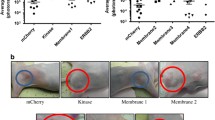Summary
Populations of normal and tumorigenic epithelial cells were plated in normal (serum supplemented) and a minimal defined medium. The ability of cells to grow in the minimal defined medium vs. the normal medium was related to their tumorigenic ability. All of the clones that were capable of growth in the minimal defined medium demonstrated tumorigenic ability. None of the normal clones survived in the minimal defined medium. As expected, some of the tumorigenic clones could not grow in the minimal medium. However, at no time did a clone that grew in the minimal defined medium fail to demonstrate tumorigenic ability. This validated that this system can be an animal-free means for selecting tumorigenic epithelial cells out of a mixed population.
Similar content being viewed by others
References
Berwald, Y.; Sachs, L. In vitro transformation of normal cells to tumor cells by carcinogenic hydrocarbons. JNCI, 35:641–661; 1965.
Chiang, L.-C.; Silnutzer, J.; Pipas, J. M., et al. Selection of transformed cells in serum-free media. In Vitro Cell. Dev. Biol. 21(12):707–712; 1985.
Iype, P. T.; Allen, T. D.; Pillinger, D. J. Certain aspects of chemical carcinogenesis in vitro using adult rat liver cells. In: Gerschenson, L. E.; Thompson, E. B., eds. Gene expression and carcinogenesis in cultured liver. New York: Academic Press; 1975:425–440.
Jariwalla, R. J.; Aurelian, L.; Ts'O, P. O. P. Temporal acquisition of phenotypic alterations and tumorigenicity in cells exposed to DNA of herpes simplex virus type 2. Proc. Seventieth Annu. Meet. Am. Assoc. Cancer Res., 20, 153; 1979.
Morel-Chany, E.; Guillouzo, C.; Trincal, G., et al. “Spontaneous” neoplastic transformation in vitro of epithelial cell strains of rat liver: cytology, growth and enzymatic activities. Eur. J. Cancer 14:1341–1352; 1978.
Schaeffer, W. I. The long-term culture of a diploid rat hepatocyte cell strain. In: Borek, C.; Williams, G. M., eds. Differentiation and carcinogenesis in liver cell cultures. Ann. NY Acad. Sci. 349:165–182; 1980.
Schaeffer, W. I.; Heintz, N. H. A diploid rat liver cell culture. IV. Malignant transformation by aflatoxin B1. In Vitro 14:418–427; 1978.
Schaeffer, W. I.; Polifka, M. D. A diploid rat liver cell culture. III. Characterization of the heteroploid morphological variants which develop with time in culture. Exp. Cell Res. 95:167–175; 1975.
Schaeffer, W. I.; von Kreuter, B. F.; Reichard, E. A., et al. The delection of malignantly transformed rat liver cells using a hormonally defined medium. In Vitro 19:108–110; 1983.
Author information
Authors and Affiliations
Additional information
This work was supported in part by grant RO1-CA40206 from the National Cancer Institute, Bethesda, MD.
Rights and permissions
About this article
Cite this article
Schaeffer, W.I., Simkins, S.G. & Lamore, B.J. A system employing a minimal defined medium for the selection of tumorigenic cells. In Vitro Cell Dev Biol 26, 737–740 (1990). https://doi.org/10.1007/BF02624431
Received:
Accepted:
Issue Date:
DOI: https://doi.org/10.1007/BF02624431




